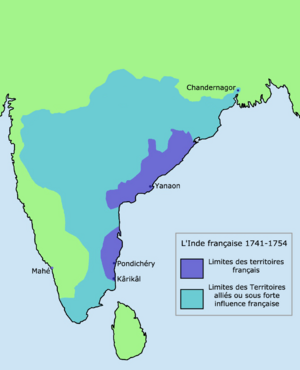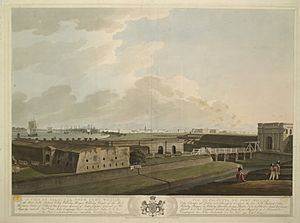Siege of Calcutta facts for kids
Quick facts for kids Siege of Calcutta |
|||||||
|---|---|---|---|---|---|---|---|
| Part of Seven Years' War | |||||||
|
|||||||
| Belligerents | |||||||
| Commanders and leaders | |||||||
| Strength | |||||||
| 30 - 50,000 men | 515 - 1000 men | ||||||
| Casualties and losses | |||||||
| Unknown | 500 | ||||||
The Siege of Calcutta was an important battle that happened on June 20, 1756. It was fought between the Bengal Subah, led by its ruler, the Nawab Siraj ud-Daulah, and the British East India Company. The Nawab wanted to take control of Calcutta (now Kolkata) because the British had built new defenses at Fort William without his permission. The Nawab's forces surprised the Company and won a big victory.
Contents
Why the Siege Happened
At the end of the 1600s, the East India Company set up a trading post near Calcutta. They bought three small villages, which later grew into the city. They also started building Fort William to protect their soldiers and goods. In 1717, the Mughal emperor Farrukhsiyar gave them special permission to trade in Bengal without paying taxes. This helped the city of Calcutta grow and become a busy trading center.
The rulers of Bengal, called the Nawabs, usually allowed European traders (like the British, French, and Dutch) to trade. However, they made them pay high taxes.
In 1756, the old Nawab, Alivardi Khan, passed away. His grandson, Siraj ud-Daulah, became the new Nawab of Bengal. Siraj ud-Daulah had a very different way of ruling. He was quick to act and didn't trust the British. He especially wanted to capture Calcutta because he believed there was a lot of treasure there. From the moment he became Nawab, he looked for reasons to remove the British Company from his lands. He found two main reasons.
First Reason: Harboring an Official
The first reason involved a man named Kissendass. He was the son of a high-ranking Bengali official, Raj Ballabh, whom Siraj ud-Daulah disliked. After Kissendass was briefly jailed, his father helped him and his pregnant wife enter Calcutta with their family's money. At the same time, Raj Ballabh joined others who were against Siraj ud-Daulah becoming Nawab.
The British officials in Calcutta continued to protect Kissendass even after Siraj ud-Daulah became Nawab. They refused his demand to hand over Kissendass and his money. This made the young Nawab believe that the British Company was working with his enemies.
Second Reason: Building Fortifications
The second reason was about new defenses being built by both the British Company and the French. These two European powers had been fighting for control in another part of India called the Carnatic. In Bengal, they had mostly kept the peace, focusing on trade. But with war starting between their countries in Europe, officials in Calcutta and Chandernagore decided to strengthen their defenses.
When the new Nawab learned about these new fortifications, he immediately ordered them to stop building. He told them to tear down any new structures. He promised to protect both foreign trading posts, just as his grandfather had done. The French understood how weak their position was in Bengal. They politely replied that they were only repairing old buildings, not building new ones.
The British Company, however, reacted differently. Roger Drake, the acting governor of Calcutta, said they were only preparing for their own safety. He strongly suggested that the Nawab would not be able to protect them.
The Siege Begins
First Battles and Warnings
Soon, rumors spread that the British Company was gathering soldiers from Madras (now Chennai) and planning to attack Bengal.
By the end of May, a huge army of 50,000 soldiers was ready under the command of Raj Durlabh. The Nawab sent a letter to Governor Drake, which was like a declaration of war.
The first problem for the British Company happened quickly. On June 3, the Nawab's forces surrounded the British East India Company's fort at Cossimbazar. This fort had only 50 men and was not ready for a fight. Two days later, the soldiers surrendered. The Nawab's army took all the Company's guns and ammunition. Then, they marched towards Calcutta.
Defending Fort William
When the news of the disaster at Cossimbazar reached Fort William, the British officials became very worried and unsure what to do.
Acting Governor Drake was not good at planning or making decisions. He was also very arrogant, which had made most of his own people dislike him. The few capable and sensible men there were too low in the Company's ranks, so their advice was ignored.
After the small fort at Cossimbazar was lost, Drake and his council sent urgent requests for help to the French and Dutch settlements. But neither wanted to join the British Company in their trouble.
The Company then begged the leaders in Madras to send more soldiers. However, the battle for Calcutta was decided before their letters could even be answered. Drake then tried to calm the Nawab's anger by promising to agree to all his demands, but it was too late.
Only then did the council members finally look at Fort William's condition. They found that the fort had been ignored for so long that it was falling apart. The fort's walls, which were 18 feet tall and 4 feet thick, were crumbling in many places. Along the east wall, large openings had been made during the long years of peace to let in air and light. The wooden platforms where cannons were placed were so rotten that they could not hold many cannons. Most of the cannons themselves were unusable. All the warehouses outside the south wall blocked any firing from the two southern parts of the fort.
The Company's chief engineer, John O'Hara, told the council to knock down the buildings around the fort. This would give the defenders a clear view of any enemy attacking from any direction. However, this would mean tearing down the houses of the council members and chief military officers. So, the council ignored O'Hara's idea. Instead, they decided to create a defensive line only around the Company's area near Fort William. They left the large area of local homes and markets, known as "Black Town" (where over 100,000 Indians lived), to the attacking army.
Cannons were placed across the three main roads leading to the fort from the North, South, and East. The smaller streets were blocked by wooden fences called palisades.
The defense plan needed enough soldiers to man the line. But when the soldiers were gathered, everyone, including Captain-Commandant Minchin, was surprised. There were only 180 men ready for duty, and only 45 of them were British or Irish. The rest were of mixed European and Indian heritage, and their fighting skills were questioned.
A group of volunteers was quickly formed from young Company trainees (called 'writers'), the crews of ships in the harbor, and other Europeans. Manningham and Frankland, who Drake had made Colonel and Lieutenant Colonel, were put in charge of this group. This group added another 300 men to Calcutta's defense, making a total of 515 soldiers.
Preparing the defenses was made harder because many local workers, called lascars, ran away. Most of the people from Black Town also fled as news of Siraj ud Daula's army approaching spread.
Omichand and the "Black Hole"
Omichand was a wealthy Hindu man who owned a house in the European area called "White Town". He had recently lost his important job as the main agent for the East India Company in its dealings with the Bengalis.
People began to suspect that Omichand, to get revenge, had secretly encouraged Siraj ud Daula to attack the Company's outpost. This suspicion was confirmed when two letters from the Nawab's camp were found addressed to Omichand.
Kissendass, who was staying at Omichand's house, was also arrested. They were both put in a small jail near Fort William's southeast bastion (a projecting part of the fort). This room was poorly lit by two small, barred window slits. It smelled bad and was very hot, earning it the nickname, "The Black Hole."
The Nawab's Attack
On June 13, the first part of the Nawab's army was within 15 miles of Calcutta, just a day's march away. All English women and children were ordered to go inside the fort for safety. The outer cannon placements and wooden fences were quickly finished. The Nawab's army then surrounded Fort William and attacked the south wall. The British cannon operators didn't have time to get their guns ready, and the Indian soldiers quickly swarmed in. They then attacked the rest of the fort, and in a short time, the fort was captured.
What Happened Next
The British prisoners were held in the prison known as the Black Hole. One survivor, John Zephaniah Holwell, wrote that 146 Company prisoners were put into a room measuring 18 by 15 feet, and only 23 survived the night. This story became very famous, but the exact details are now widely debated by historians.
The city, which the Nawab renamed "Alinagar," was only lightly guarded by the Indian forces. In January 1757, a British force led by Robert Clive recaptured it. The Nawab tried to counter-attack, but his forces were defeated outside the city on February 2. This led to an agreement called the Treaty of Alinagar, signed on February 9. This treaty allowed the East India Company to keep the city and fortify it. It also gave them freedom from taxes.
However, the situation was still unstable. Siraj ud-Daulah had to send many of his soldiers west to protect his land from Ahmad Shah Durrani. This made him militarily weak. Also, he was not popular at home, and there were many political plots against him in his court. This gave the East India Company a chance to try and replace him with a new Nawab. Meanwhile, Siraj's growing involvement with the French East India Company gave the British a reason to go to war again.
This led to the Battle of Plassey on June 23, 1757. Siraj ud-Daulah suffered a major defeat because he was betrayed by Mir Jafar, a military commander who had secretly agreed to switch sides. This battle firmly established the East India Company's control over Bengal, with Mir Jafar becoming the new Nawab. The Battle of Plassey is generally seen as the beginning of Company rule in India, and the first big step in the development of the British Empire in India.
See also



